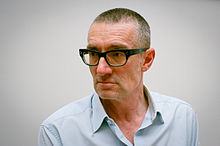Thomas Hirschhorn
| Thomas Hirschorn | |
|---|---|
 |
|
| Born |
16 May 1957 Bern, Switzerland |
| Nationality | Swiss |
| Education | Zurich University of the Arts |
| Known for | Installation art |
| Movement | Contemporary art |
| Awards | Marcel Duchamp Prize, Joseph Beuys Prize, Kurt Schwitters Prize |
Thomas Hirschhorn (born in Bern, 16 May 1957) is a Swiss artist. He lives and works in Paris.
In the 1980s, Hirschhorn worked in Paris as a graphic artist. He was part of the group of Communist graphic designers called Grapus. These artists were concerned with politics and culture, displaying impromptu creations and posters on the street mostly using the language of advertisement. He left Grapus to create the hypersaturated installations he is known for today, using common materials such as cardboard, foil, duct tape, and plastic wrap. He has described his choice to use everyday materials in his work as "political" and that he only uses materials that are “universal, economic, inclusive, and don’t bear any plus-value”. Hirschorn's installations are often site specific and outside the gallery, and/or interactive. He continues to offer messages in his work, as he did with Grapus. He has said that he is interested in the “hard core of reality”, without illusions, and has displayed a strong commitment to his work and role as an artist. He has described working and production as “necessary”, discounting anyone who encourages him to not work hard, and says “I want to be overgiving in my work”.
Austrian author and Nobel laureate Elfriede Jelinek takes issue with the artist's views on Marxism. In a 2008 interview, the artist said that he was not aware of her concerns.
For his piece Cavemanman, he transformed a gallery space into a cave using wood, cardboard, and tape and put various philosophical and pop culture symbols throughout it.
Gramsci Monument (2013), named after the Italian thinker Antonio Gramsci, is the first project that Hirschhorn has built in the United States and the fourth and final such work in a series he began many years ago dedicated to his favorite philosophers, following a monument dedicated to Baruch Spinoza in Amsterdam in 1999, one to Gilles Deleuze in Avignon, France, in 2000 and a third to Georges Bataille in Kassel, Germany, in 2002. From the beginning, the monuments have been planned and constructed in housing projects occupied mostly by the poor and working class, with their agreement and help.
He presented a lecture as part of the "Image & Text: Writing Off The Page" lecture series through the Visiting Artists Program at the School of the Art Institute of Chicago in Spring, 2006.
...
Wikipedia
